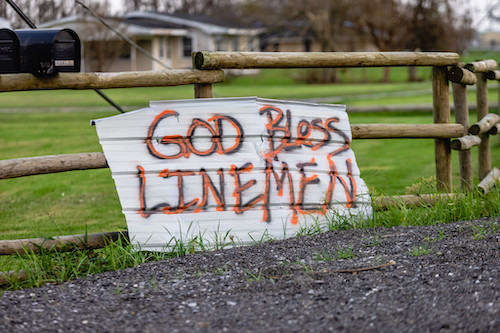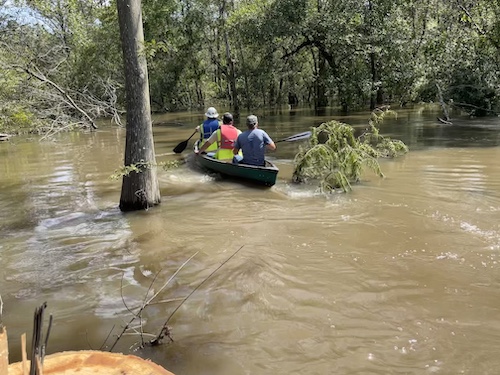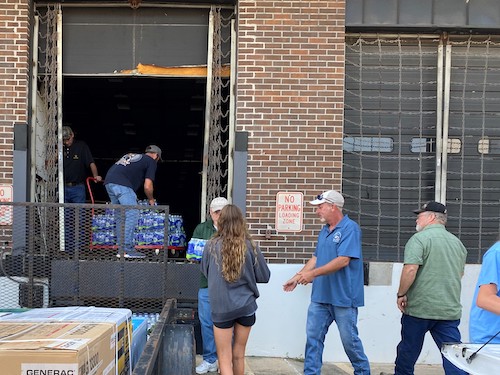Power poles were littered like matchsticks across the Bayou region, transmission lines destroyed, a million people without power.

|
A sign in front of a Lockport, La., home, one of many ways storm-weary residents showed their appreciation to local and traveling line crews.
Photo courtesy of Entergy.
|
Before Hurricane Ida cut its deadly path northeast, ultimately drowning dozens of people in Philadelphia and New York City, it made landfall in southeast Louisiana with more force than any storm the state had recorded since the mid-1800s.
Its Category 4, 150-mph winds devastated Louisiana’s power grid, with Entergy alone reporting damage to more than 30,000 power poles, 36,000 spans of wire and nearly 6,000 transformers.
“It was more like a tornado than a hurricane. The wind damage was unbelievable,” Baton Rouge Local 995 Business Manager Jason Dedon said.
“It ripped houses apart — not just the usual trailers and fifth wheels and mobile homes,” he said. “We’re talking about foundation-built houses. Driving down the interstate, you could see right into somebody’s living room.”
Dedon’s local represents all outside line construction for Louisiana. He said more than 40 signatory contractors were on the ground after Ida, deploying upwards of 5,000 IBEW members.
Under the IBEW’s mutual assistance agreements with utilities, thousands more linemen from 38 states headed to Louisiana, as well as Mississippi and Alabama, Utility Director Donnie Colston said.
“About 24,000 to 30,000 linemen in all, working for utilities and outside contractors, were sent to the Gulf,” he said. “It’s not the highest response we’ve had after a hurricane, but it is one of the higher ones.”
In terms of the grid, Ida delivered the biggest blow to southern Louisiana and Mississippi. Wreckage exceeded even what Hurricane Katrina left in its monstrous wake when it struck on the same day, Aug. 29, in 2005.
In the hardest-hit southern parishes, linemen at rural electric cooperatives couldn’t believe their eyes.
“I talked to one of my guys who said that for every 200 light poles, there were maybe two still standing,” said Bogalusa Local 1077 Business Manager Mickey Fortenberry.
Out-of-state crews were stunned, too.
“It just looked like a war zone,” said foreman Travis Garrison of Louisville, Ky, Local 2100, one of roughly 60 workers sent by Louisville Gas & Electric.
“Just about everybody’s power was out,” he said. “It was almost overwhelming. We knew we had to get going, try to take it one step at a time.”
Crews worked 16 hours a day, 7 days a week, in brutal heat and humidity. Storm-weary residents greeted them like heroes.
“When you go into the towns, you see everybody waving, tooting their horns, trying to hug you,” Garrison said.
Cajun cooking was another way residents showed their appreciation, he and others said, with roadside feasts of pastalaya, jambalaya and more.
In New Orleans, which escaped the worst of Ida’s wrath, crews restored power to most homes within a few days. Over the next week to 10 days, more than 90% of all customers were back on the grid.

|
| Restoring power in the Bayou included a canoe trip for Louisville Local 2100 foreman Travis Garrison and his crew, who were vigilant about avoiding alligators and other swamp creatures.
|
But many isolated rural residents weren’t as fortunate. For them and thousands of linemen still on the job, things were about to get worse before they could get better.
Ida’s tropical cousin Nicholas arrived from Texas Sept. 14 with a wind-whipped deluge that added flooding to the list of Gulf miseries.
“We were watching the forecast, thinking the universe owes us one, we’re bound to get a break. We didn’t,” Dedon said. “It rained for two days straight, so hard you couldn’t see at times, up to 9-10 inches an hour.”
It reminded him of the “astronomical rain bands” that he remembered all too well from Katrina.
Ida was a different kind of beast, nowhere near as wide or wet as Katrina. But its violent winds left people scrambling for Army-standard blue tarps to nail down over battered roofs.
With many homes still open to the elements as Nicholas loomed, Dedon said Local 995 office staff delivered tarps to people in need, including linemen’s families.
“Everyone helped out, getting tarps up to protect what people hadn’t lost yet,” he said. “Not all roofs suffered catastrophic damage from Ida, but there was enough damage that they weren’t going to hold up to that kind of rain.”
Nicholas’s torrential rain and flooding slowed down work in remote areas of the bayou where many customers were still days or weeks from getting their power back.
“It delayed some repairs for a couple of days,” Dedon said. “We’re down to the smallest portions of the hardest-hit areas — those roads where there are no poles left, where trees are blocking access. But it’s going to be close to the end of the month before there’s a semblance of normalcy there.”
Local 1077’s Fortenberry said Ida toppled scores of Georgia pines and “a lot of old, old oak trees,” many of them bringing poles and wires down with them.
Many trees were fully uprooted, others had limbs twisted off and some, he described, “are broke off 20 feet above the ground. It’s like your elbow, if you hold your elbow shoulder height and hang your arm down.”
The towering pines, especially, were a sight to behold for visiting linemen.
“The size of the trees, there’s nothing like it in Kentucky,” said George King, another Louisville Local 2100 foreman. “It’s shocking how tall they are.”
His local brother, Garrison, said, “We were counting rings on trees to find out how old they were. We counted anywhere from 50 to 120 rings on some.”
One of the downed trees that King’s crew cut turned out to be home to a hive of honeybees. “You should have seen us scatter,” he said.
King had other encounters with nature in the bayou, like the day he looked down and saw hundreds of fire ants climbing up his leg. Then there was the armadillo, likely rabid, that charged him and his crew.
Garrison, whose crew often worked with King’s along the northern coast of Lake Pontchartrain, had adventures of his own.
“Everyone wants to help get their lights back on,” he said, by way of telling a story about one especially eager customer — a man who boasted of a relative who’d appeared on the TV show “Swamp People.”
“‘You’ll never find this wire unless I take you,’ he told us,” Garrison said. “So, we took a canoe ride up a bayou. We would never have found our way without him.”
They were ready for alligators in the swamp, but learned they had to be vigilant against other, unexpected dangers. “We saw some absolutely huge spiders,” he said. “And people told us to be careful when shaking trees, because water moccasins sometimes hang out in treetops.”
The courage and compassion of IBEW members in the wake of major storms fills Fifth District International Vice President Brian Thompson with pride.
“I couldn’t be prouder of or more grateful to the IBEW crews that spend weeks in harsh conditions away from their families to restore power to hundreds of thousands, if not millions of customers; of the members who jump into action as volunteers to support storm victims and deliver food, water and other necessities to them; and of the charity of our Fifth District locals through the union’s Unity Fund,” he said.
Hurricanes leave many IBEW families in the same desperate situations as their neighbors, and Thompson had long wanted to find a way to streamline the process of providing aid as quickly as possible after a storm.
That began happening last year, he said, when International President Lonnie R. Stephenson “generously approved our request to use the Unity Fund to allow Fifth District locals to give and receive contributions. Now locals with members in need after a storm are able to put the money to work directly for them.”
“Dollar for dollar, no fees, no taxes, it all goes to the locals to distribute,” he said. “Last year we raised $127,000 to help the brothers and sisters in Lake Charles, Louisiana. It is truly a testament to the generosity and kindness that is the essence of the IBEW.”

|
| IBEW members in Baton Rouge with help from their city’s Pipefitters load water and other relief supplies at a warehouse that Local 995 purchased to convert into a training center. The local expects to turn part of the centrally located building into a permanent relief center stocked with supplies for future storms.
|
The same spirit is evident across the street from Local 995’s offices in Baton Rouge, where leaders turned a warehouse they bought to build a training center into relief space that’s become a hub for labor donations and volunteers.
“It’s a distribution spot to load and offload vehicles,” Dedon said. “We had apprentices who weren’t able to go back to work, retirees, some of our linemen and wiremen showing up to help.
“President Stephenson authorized a tractor-trailer of water. The Teamsters brought in a tractor-trailer of water. The Florida AFL-CIO sent 55-gallon drums of gasoline because there was a gas shortage.”
After launching the operation on its own, Local 995 signed an agreement with the American Red Cross, whose own building was overwhelmed by the region’s needs.
Dedon said the goal now is to set up a permanent, well-stocked relief center by slightly reducing the footprint of the planned training space.
“It’s not a matter of if we’re going to get hit with another hurricane. It’s a matter of when and how bad,” he said. “It seems like every hurricane we fall into this reactive space. We’re begging for water three, four days later. We know we’re going to need water, we’re going to need food, we’re going to need tarps.”
His local will take the lead, but he, just like Thompson, knows they can count on other IBEW locals and fellow unions to step up.
“It’s truly the local unions that really make this brotherhood a brotherhood,” Dedon said.
See more photos of the restoration work on Entergy’s Hurricane Ida Flickr page.